Top News
October 10, 2013 Wu Li Jun of Ryukyu Shimpo
The Diving Resort Travel Expo 2014 will be held at the Okinawa Convention Center in Ginowan from June 20 to 22 next year. This expo is widely regarded as the largest diving and travel event in the Asia-Pacific region.
Hong Kong based event company LX Development Group Ltd will host the expo and the Okinawa Prefectural Government and Okinawa Convention & Visitors Bureau (OCVB) have succeeded in attracting the event.
The expo aims to tap into the market in China and Southeast Asia of people interested in diving.
It will provide information on diving, showcase the latest dive equipment and hold seminars. Through various events held over three days the expo will aims to explain the charm of the sea around Okinawa to the Asian regions. The official name of the expo is the Japan Okinawa International Diving Resort Travel Expo.Seventeen countries and regions, including Fiji and Guam will send 80 to 100 companies and organizations involved in dive equipment and tourism.
The expo has previously been held in Hong Kong and Singapore and the organizer also plans to hold the event in Shanghai next March. On average, more than 12,000 people attend.
The representative of LX Development Group Ltd said, “We decided to hold the event in Okinawa because the prefecture has the most beautiful diving spots in Northeast Asia.”
According to the Chinese Underwater Association, China currently has about 100,000 divers, with the number increasing by an average of 30 percent every year.
The OCVB has taken part in the events held in Hong Kong and Singapore and plans to be represented at the expo in Shanghai. It uses diving events to promote Okinawa tourism.
(English translation by T&CT, Mark Ealey)
Go to Japanese
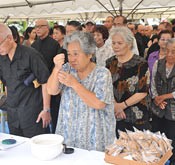
October 11, 2013 Ryukyu Shimpo
This year marks 69 years since the U.S. military launched the large scale air raid on Naha on 10 October 1944. The Naha City War Dead Joint Association organized the 18th memorial service in front of Naguyake Peace Monument of Naha City Wakasa Seaside Park on October 10. The monument enshrines the souls of the more than 29,000 people from Naha who died in the Battle of Okinawa, including the victims of the air raid. About 120 people from bereaved families attended the ceremony, praying for the victims of the war and for lasting peace. The participants paid their respects with one minute’s silence.
The chairman of the association, Masamitsu Omine, said in his speech, “Unexploded ordnance is buried underground as the negative legacy of the war and human bones still lay in the hills and fields. We have a responsibility to continue to convey to our children and grandchildren the stupidity and misery of war and how precious life is. We must not allow wars to happen.”
Seventy-eight-year-old Tadamune Kudaka lost his father in the air raid. After that, all of his family members except for his father were evacuated to Kumamoto. “I don’t have any of my father’s remains nor any memento to remember him by. Because I was young, I don’t remember much about him at all. Today I came here to say to him that I have gone on to grow up.” Kudaka said.
Tomiko Inafuku, who is 79 years old and experienced the 10 October air raid, said, “I remember that day well. I saw many dead bodies in Naha. The city was a sea of fire. The sound of U.S. warplanes during the ceremony brought back memories of that day. I never want to experience war again.”
During the memorial service, a U.S. Marine Corps’ MV-22 Osprey flew nearby. The noise from its engines sometimes drowned out the voices of those reading the sutras and funeral speeches.
(English translation by T&CT, Lima Tokumori and Mark Ealey)
Go to Japanese
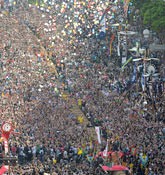
October 14, 2013 Ryukyu Shimpo
The 43rd Naha Ozunahiki (Naha Tug of War) was held at the Kumoji intersection of Route 58, in Naha on October 13. According to the organizers, about 277,000 people took part. The people pulled on a giant straw rope 200 meters long and weighing 43 tons, which the Guinness Book of World Records recorded as the world’s largest. The participants separated into the East and West teams and after the 30-minutes of tugging on the rope, the judges decided that the East team had won. This is the fifth time that the winners have been decided in this manner.
The score of 13 wins and 13 losses each plus 14 draws through the years leaves the teams tied in terms of overall results.
Before the tug of war, the hatagashira parade set off from Tsuboya Elementary School in Naha. With 14 flags from both the teams ready at the intersection of Route 58 in Kumoji, the flag-waving competition began. The participants then held the kanuchichiji ceremony to connect the male rope of the east side with the female rope of the west side.
The tug of war commemorated the establishment of Naha City as Okinawa’s major urban area. Minoru Higa, the head of the Naha Ozunahiki Preservation Association, said, “We have been blessed with fine weather. I would like the participants to really enjoy this traditional festival.”
(English translation by T&CT, Mark Ealey)
Go to Japanese

Go To Video
October 9, 2013 Ryukyu Shimpo
Newly disclosed National Archives documents expose the details of hideous acts by the Imperial Japanese Army in trampling on the human rights of women. The documents include the judicial records of nine Japanese military officers and civilians convicted by a provisional military tribunal set up by the Netherlands in Jakarta in the former Dutch East Indies. In 1944, during the war, they took 35 Dutch women detained in a camp on Java Island in Indonesia by force to serve as so-called comfort women for Japanese soldiers. The National Archives disclosed the documents to a civic group.
The Japanese military selected the women at the camp and took them to four “comfort stations” where they were made to provide sex. The documents include vivid testimonies of the officers who forced the women to become objects for Japanese soldiers to vent their sexual frustrations on. Some officers said in their testimonies, “We asked the chief of the provincial police to select women at the camp for brothels,” “The women were brought out by provincial officials at the request of (an officer’s name),” and “The women were not told about the work they would be doing until they arrived at the brothels.”
The roughly 530 pages of documents include the background evidence used for then Chief Cabinet Secretary Yohei Kono’s statement in 1993. In the statement, Japan acknowledged and apologized for its military’s involvement in the recruitment of women into sexual servitude. The documents are sufficiently reliable to prove that the military forced women into sexual slavery.
Jan Ruff-O’Herne, a victim of the Japanese military, spoke at a university in Australia in 2008. She said: “I was taken out of the prison camp by the Japanese and put in a brothel for the Japanese military to become a so-called ‘comfort woman,’ a euphemism for a military sex slave.
And so, you live with this fear. I still have nightmares. I had one miscarriage in the brothel and another three miscarriages afterwards, after I got married, because my body was just so broken.”
The Japanese Army’s sinful behavior is encapsulated in her excruciatingly painful experiences. Her testimony that the Japanese military took her and other women away, deprived them of their freedom and forced them into sexual servitude for Japanese soldiers, resulting in her and others becoming physically sick, needs to be taken seriously. The appearance of dissenting opinions in Japan has hurt the former comfort women. Such opinions tend to focus only on whether or not there was direct use of physical force or threats by the Japanese military.
However, separate to the controversy over the issue of coercion by the military, the international community has taken a firm stance on sexual violence in wartime. That the Japanese military drove women into sexual servitude causes a feeling of repulsion. How would you feel if your daughter were placed in that situation? Thinking from the viewpoint of ordinary people, we need to understand how sternly the international community views Japan on the comfort women issue. Twenty years have passed since the Kono Statement. Evidence pointing towards coercion by the military has appeared repeatedly. Prime Minister Shinzo Abe has suggested that he might revise the Kono statement. Now is the time for Abe to declare to the international community that he does not intend to review the Kono Statement.
(English translation by T&CT, Mark Ealey)
Go to Japanese
October 10, 2013 Ryukyu Shimpo
Naha Mayor Takeshi Onaga held a regular press conference on October 9. In response to a question about the Kyoto District Court banning hate speech around a school for ethnic Koreans, Onaga said, “I am anxious about what is going on in Japan.”
Onaga visited Tokyo this January to take part in the protest parade demanding that the U.S. and Japanese governments cancel the deployment of the Osprey to Okinawa. Some of the people who waved Japanese flags hurled abuse at those in the parade, saying, “Get out Ryukyuans! Chinese spies! Onaga, come and show yourself!” Onaga said, “Japanese people need to be careful in considering the dignity of Japan.”
When Onaga and other protesters were exposed to hate speech, people walking past just ignored it, and went about their business, which surprised Onaga. He said, “I felt uncomfortable about seeing such abnormal behavior within such a normal setting.”
Some groups criticize Onaga and the Okinawa media through sound trucks moving around the Naha City Office.
Onaga said, “The noise doesn’t particularly concern me, but I do feel sorry for local residents. We should consider why such hate speech has gone as far as it has.”
(English translation by T&CT, Mark Ealey)
Go to Japanese
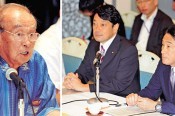
Ocotber 9, 2013 Ryukyu Shimpo
Okinawa Governor Hirokazu Nakaima met Minister of Foreign Affairs Fumio Kishida and Defense Minister Itsunori Onodera in Naha in the afternoon of October 8.
Nakaima said, “I cannot understand why the U.S. and Japanese governments claim that the plan to move U.S. Marine Corps Air Station Futenma to the Henoko district in Nago is the only possible solution.”
Criticizing the agreement reached on October 3 by both governments in the U.S.-Japan Security Consultative Committee, otherwise known as the “two-plus-two” security meeting, Nakaima said that moving the facilities currently at Futenma Air Station within Okinawa is impossible. He suggested, “Moving the base outside the prefecture is a quicker solution, both in terms of feasibility and time involved to carry it out.”
The policies decided in the meeting to reduce the burden of bases on Okinawa and the U.S. government changing the way to implement the Japan-U.S. Status-of-Forces Agreement on notifying the Japanese government about prosecuting military personnel who commit crimes, met with a relatively favorable response.
After the meeting, Nakaima talked to the press about whether or not he will approve the application documents to reclaim land off Henoko in Nago. He said, “I cannot make the final decision until I read the opinion of the Nago mayor. He will give that at the end of November.”
Onodera said, “The Japanese government intends to negotiate with the U.S. government on the transfer of MV-22 Osprey training outside Okinawa and Japan.” Nakaima replied,”Okinawan people are still concerned about the safety of the Osprey.” While the U.S. government has decided to cancel the restriction on using the water around the so-called “Area Hotel-Hotel” airspace and waters designated as a training area, it also has decided to allow Okinawan people to carry out surveys of the land the military plans to return. Nakaima said, “I want the U.S. and Japanese governments to came forward with specific plans and then carry them out.”
After the meeting, Onodera said, “The atmosphere in the meeting was not bad at all. I want work hard to reduce the burden of bases on Okinawa and to get the governor to approve the land reclamation application so the base can be built.” Kishida said, “We want to politely move forward in our discussion.”
Nakaima had dinner with Kishida in Naha in the evening of October 8. After that, he talked to the press, saying, “We did not discuss the plan to move the base to Henoko.”
Kishida and Onodera met Lieutenant General John Wissler, Commanding General, III Marine Expeditionary Force Okinawa Area Coordinator and the leaders of the Okinawa business community to explain the policies designed to reduce the burden of bases.
(English translation by T&CT, Mark Ealey)
Go to Japanese
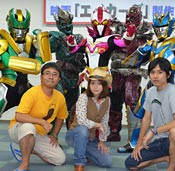
October 4, 2013 Ryukyu Shimpo
The movie version of the TV drama Halser Acre will be released next spring. This popular drama series focusing on food and the natural environment was aired by the Okinawa Television Broadcasting (OTV) from 2011 to 2012. The announcement was made on October 3 at the OTV office in Naha with director Tsukasa Kishimoto and members of the cast AKINA, Moeko Fukuda, Shinichi Tsuha, Tomoji Yamashiro in attendance.
New character, Halser Halu, original characters Nogu Gama and Heler dressed in newly designed special effect suits, and villains Samarin Tandoboo and Chilly appeared at the press conference. Yuki Yamada, who is in charge of screenplay, said, “The theme of the TV drama Halser Acre was that Superman defends the Earth. Through the movie version we would like get people to think about what each of us can do to help protect the Earth.” Filming started October 6 in Okinawa. The movie will be released in Okinawa sometime after the end of May 2014, then in other prefectures and in Taiwan.
(English translation by T&CT, Hitomi Shinzato and Mark Ealey)
Go to Japanese
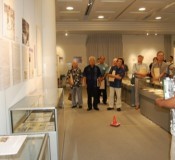
October 10, 2013 Ryukyu Shimpo
The Okinawa Peace Memorial Museum is running a special exhibition called “The war and Okinawa through the eyes of Hawaii’s Uchinanchu” from October 10 to December 11. Admission is free. It displays 189 materials such as documents showing how Japanese immigrants in Hawaii were involved with Okinawa before and after the war.
The display items include new video footage including a documentary film about people of Okinawan descent sending goats as food aid to Okinawa after the war. There are also video recordings of interview testimony by Takejiro Higa and Shinei Gima who had been drafted by the U.S. military and took part in the Battle of Okinawa as interpreter soldiers. At the opening ceremony Museum Curator Miwako Ueyonahara said, “Through Uchinanchu working hard during and after the war, we want visitors to sense human dignity and a desire for peace that transcends national borders. They fought against the motherland during the war and then supported the Okinawan people after the war.”
(English translation by T&CT, Mark Ealey)
Go to Japanese
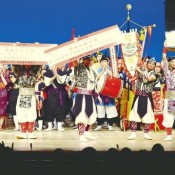
October 8, 2013 Ryukyu Shimpo
Eisa groups from both inside and outside Okinawa competed in the Worldwide Eisa Festival held at the National Theater Okinawa in Urasoe on October 6. Thirty groups, including some from overseas entertained the audience with their unique dance performances using both traditional and innovative eisa styles.
The creative performance group Requios won the Grand Prix, and so took the top award in the festival for the second year in a row.
The organizers shortened the event from two days to one day because Typhoon Fitow was heading towards Okinawa on October 5.
The Kobudo Drum Group Kazanomai won the second prize followed by Eisa-Crew Crown.
As an extra prize, the organizer awarded the winner the right to create an original eisa song.
Toshito Teruya, the leader of the group said, “We have won the competition for two years in a row thanks to the support of many people. It is great that the audience enjoyed our performances.”
(English translation by T&CT, Mark Ealey)
Go to Japanese
October 2, 2013 Ryukyu Shimpo
The Japanese Government agreed on October 1 to accept terms of settlement by which they pay damages to the family members of a male employee who died from an asbestos-related disease after working on U.S. military bases. Two male employees who worked on U.S. bases before Okinawa’s reversion to Japanese sovereignty in 1972 died of lung cancer caused by asbestos. Their family members had filed a damage suit against the government. This is the first time that the government has accepted a settlement for damages related to asbestos-related disease in Okinawa.
The government agreed to pay 25 million yen, as the Okinawa Branch of the Naha District Court requested, to the family members of the employee who passed away at 79 years-of-age in 2002.
One of the family members who settled with the government said, “I was worried about this being the first case of its kind in Okinawa, but now I’m happy with the outcome. I hope that other people who might have been exposed to asbestos will also take legal action.”
At the same time, the family members of an employee who died of idiopathic pulmonary fibrosis in his 80s in 2010 have not settled with the government. They intend to continue negotiations. According to the plaintiff’s lawyer, Naoyuki Toyama, because he worked replacing asbestos equipment, the government has acknowledged the causal relationship between the death of the employee and his job on base.
(English translation by T&CT, Lima Tokumori and Mark Ealey)
Go to Japanese
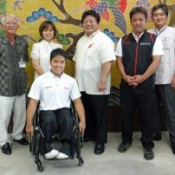
October 6, 2013 Masatoshi Itokazu, correspondent of Ryukyu Shimpo
Ginoza High School student Keisuke Shiroma told the town mayor on October 2 that he will represent Japan in the Asian Youth Para Games to be held in Malaysia from October 26.
Shiroma has won five consecutive titles in the Ginowan Wheelchair Marathon and has also taken part in the Oita Wheelchair Marathon and the Japan Athletic Championships for the Disabled.
In the games in Malaysia, Shiroma will compete in the 100, 200, 400 and 800-meter races.
Town mayor Takaeshi Gibu encouraged Shiroma, saying, “I congratulate you on taking part in the games. I would like you to approach them as you have previous events. Everyone here in our town will support you.”
Shiroma said, “I am good at the 800-meter race. I will do my best to win. I am glad that people will be supporting me.”
(English translation by T&CT, Mark Ealey)
Go to Japanese








 Webcam(Kokusai Street)
Webcam(Kokusai Street)


